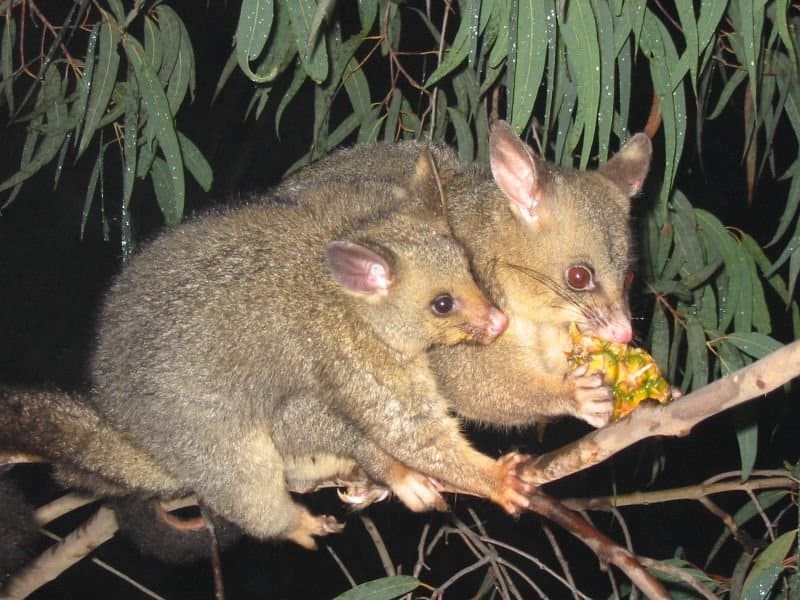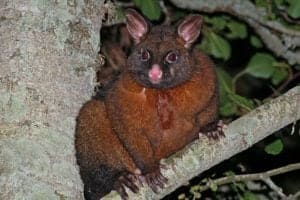Can possums climb trees, fences, and walls? It’s a good question for homeowners looking to eliminate pests from their properties or amateur naturalists hoping to catch a glimpse of a possum in its natural environment. With these animals being so shy and elusive, it’s vital to know where to look for them. Read on to find out if these cute but pesky marsupials can climb!
Can Possums Climb Trees, Fences, and Walls?

Possums can climb trees, fences, and walls.
©Bryce McQuillan, CC BY-SA 2.0, via Wikimedia Commons – License
Possums are adept at climbing trees, fences, and walls. Whether it’s the possums of Australia or the opossums of North, Central, and South America, these diminutive marsupials can climb just about anywhere they need to go. In fact, many species make their homes in tree hollows or abandoned nests, preferring arboreal life to life on the ground.
Many observers have caught an entrancing glimpse of an adorable possum peering down from a tree branch, sometimes with a joey or two perched on its back. Unfortunately, as sweet as possums may appear, they also cause problems for property owners. Because of their proficiency in scaling various objects, they easily access roofs or climb into yards. Here, they may choose to take refuge, damaging property and leaving behind nasty odors. Some even get inside houses or sheds and refuse to leave.
What Makes Possums Excellent Climbers?
A number of adaptations contribute to their arboreal dexterity. First of all, most of their toes have claws, which help them to grip tree branches, fences, and the edges of roofs. These claws aren’t long enough to cause significant damage in most cases; they’re just long enough to give their owners some extra grip.
Secondly, possums and opossums have long, prehensile tails. A prehensile tail is able to grasp objects in much the same way as a hand. Contrary to popular misconceptions, adult possums cannot hang from their tails. Their body weight would cause injury to the tail and likely result in a serious fall. However, baby possums (joeys) are light enough that they sometimes use their tails in this way. Adult possums use their tails both for balance and to grasp objects of interest.
Thirdly, possums have footpads with ridges that allow them better traction on all types of surfaces. Combined with their claws, these footpads give them a higher chance of success when scaling fences or other structures.
It turns out that, in addition to these other helpful attributes, possums have opposable thumbs. This is an enviable adaptation limited to a few select species in the animal kingdom. Animals with this adaptation are able to grasp and balance with greater ease than other species.
Possum Opposable Thumbs

Possums have opposable thumbs.
©Peter Firminger / CC BY 2.0, Flickr – License
Most nonhuman animals do not have opposable thumbs. However, the idea that humans are the only creatures in the world able to effectively grasp and manipulate objects is wrong. Both possums and opossums have opposable thumbs, making them better able to climb trees and grasp their food. There are minor differences between the opposable thumbs of possums and opossums.
Possums
All species of Australian possums except two have opposable thumbs. These occur on their hind feet as the first and second toes. Like their cousins the opossums, the fifth toes on their hind feet are also opposable and flawless.
Opossums
Opossums have opposable thumbs on their hind feet. Their fifth toes are opposable and useful for balance. Unlike the other toes on the hind feet, they lack nails. A notable exception to the general rule is the water opossum, whose webbed feet make an opposable thumb impossible. Unlike possums, opossums do not have opposable thumbs on their front feet.
Other Animals with Opposable Thumbs
A number of animals in the animal kingdom have opposable thumbs besides possums and opossums. These include:
- Great apes (humans, gorillas, chimpanzees, bonobos, and orangutans)
- Some Old World monkeys (e.g. grivets, baboons, macaques)
- Lemurs
- Koalas
- Pandas
- Chameleons
- Some species of frogs (Phyllomedusa camba tree frogs, waxy monkey frog, tarsier leaf frog, red-eyed tree frog, Burmeister’s leaf frog)
While birds don’t have opposable thumbs in the strict sense of the word, some have opposable toes called halluxes. This toe points backward. In birds of prey, it assists with catching and manipulating their food; in other species, it enables them to grasp tree branches to perch more effectively. Some bird species with “opposable thumbs” include:
- Eagles
- Hawks
- Owls
- Robins
- Jays
- Chickadees
Why Do Possums Climb Trees and Structures?
Possums climb trees and manmade structures for a few reasons. First of all, they’re looking for a place to live. Tree hollows are a favorite among possums, especially the Australian version. Alternately, possums and opossums in urban areas may climb fences or walls in search of a way into human dwellings. Attics, sheds or garages, and the undersides of houses are frequent haunts.
Possums also climb to avoid predators. Most of their natural predators can’t climb and therefore can’t pursue them above ground level. These include wolves, coyotes, dingoes, and domesticated dogs. However, these animals may be able “tree” a possum, which means trapping it in a tree or other high place without the possibility of escape.
Of course, possums have to eat, and much of their diet relies on plant matter. They find sources of sustenance in tree leaves, fruits, and shrubs. Opossums in the Americas even prey on certain small animals including birds and their eggs.
How Can I Keep Possums Out of My Yard?
There are a few ways to keep possums out of the yard and away from human dwellings. The most obvious way is to close up gaps in fences, houses, and sheds to prevent possums from moving in. However, because possums are so good at climbing, they may be able to overcome these difficulties. In these cases, scent repellants are a great way to deter them. Blood meal, bleach, ammonia, wolf or fox urine, and food products like hot peppers and hot sauce are all repulsive to possums. Strategically-placed mothballs and pet fur may also turn them away. Motion-activated sprinklers are another possible solution to furry invaders.
Possums can easily climb trees, fences, and walls, making them hard to keep out. However, there are plenty of ways to discourage them from settling in for the long haul.
Related Animals:
The photo featured at the top of this post is © Timothy Christianto/Shutterstock.com
Thank you for reading! Have some feedback for us? Contact the AZ Animals editorial team.






